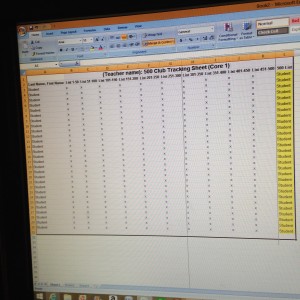Please check out my last post before reading this one. I joked about recording bathroom breaks as data on spreadsheets. More data! I laid out the basic opportunity-cost problem with gathering data on bathroom breaks, but I need to carry this exercise in what-ifs a little further.
So my fellow teachers and I start recording bathroom breaks. An interruption here, an interruption there, and pretty soon my thought processes may have holes the size of canyons in them. That’s my first problem, one I faced regularly when students spoke up wanting to read the words on their latest 500 words list.
My larger problem will be future interventions. When we gave benchmark tests this year (8 total), we recorded results for six of these tests in different spreadsheets. That data was then analyzed to determined who should receive extra help or interventions. Lower students were assigned to afterschool tutoring. Next year, those scores will affect their classroom placements. Students with the lowest scores are expected to receive no elective class of their choice due to placement in remedial classes designed to help with their academic deficits.
If my district started tracking bathroom breaks, interventions would follow. Teachers would have to wean “Oscar” from the bathroom after they determined he was spending 37 minutes each day on average hiding out in the boy’s room. Teachers would be expected to call home, probably a number of homes — repeatedly. If Oscar complained he desperately needed that bathroom pass throughout the school day, the nurse would likely have to send home a letter suggesting his parents take him to see a urologist. The nurse would then have to track these letters, and there might be quite a few of them. Boys and girls bathrooms in my former school are busy places.
Teachers might have to attend team meetings to plan out bathroom schedules for individual students and then address the issue of school rules used to address exceptions. How do we determine an emergency? Should we log emergencies? What consequences will we have for an excessive number of emergencies? What exactly is an excessive number of emergencies? Should girls receive special dispensations due to their monthly cycles? How will we deal with boys claiming discrimination? (I guarantee you that some Oscar or another would pipe up to say, “But you let Kimberly go for the last three days!”) When should we call home? The meeting might bog down, as ambitious new teachers and administrators argue larger issues: Is the passing period too short? Should we schedule a mid-morning break? If so, how will we avoid taking time from specific classes and not others? Should we have a rotating break? How will we determine break times? Should we advance the break time by ten minutes each day? How will we track this? Who will be responsible for the new bathroom break schedule tracking spreadsheet? If we share the responsibility, who will create the schedule showing when different teachers are responsible for the break schedule spreadsheet? At what time should we start these breaks? At what time should we cut them off? Do we need to liberalize the bathroom policy at lunch? What about bathroom vandalism? Should security be stationed near the bathrooms during break times? Should we allow water breaks too? How will we prevent disruption to classes that do not have a break scheduled? How will we manage breaks when we are testing? Etc. I can see this meeting in my mind and I can see myself trying to look attentive for well over an hour as we all hash out these issues, coming up with policies for some and tabling others while parceling out more noninstructional work.
I can visualize this whole damn meeting because I have sat through so many variants of this meeting. Data gathering leads to policy and interventions, which lead to meetings. And more meetings. As part of our efforts, staff will be expected to document and discuss improvements. So in a few months, we will be taking time out of the weekly seventh-grade meeting to discuss that fact that student bathroom usage has fallen 36% and our 17 identified problem students have decreased usage by a full 83%.
We might gain real benefits from this exercise in bathroom control. Classroom learning time will go up as bathroom usage goes down. But at what cost? How much time did it take to get those 17 kids on track? How much time was taken away from all of their classmates while we worked on this problem.
Eduhonesty: Good ideas run amuck are killing us out in the field here. ‘Nuff said.

